Champignons are elite mushrooms included in the daily diet of each family. They have excellent taste, easy to prepare. Of these, you can cook a large variety of dishes. If you have a cottage with a basement and the desire to please your family with these wonderful mushrooms without restriction all year round, having studied the technology, you can start their independent cultivation. Believe me, planting mushrooms is not difficult at all. And our instructions on how to do this step by step for newbies will help you in this matter.
Table of contents
Where can I grow champignons?
Mushrooms at home can be grown in beds and cellars. It is possible to grow this type of mushrooms in the garden with your own hands for some time while the weather conditions allow. But you can grow in the basement all the time. To do this, you only need to prepare a special substrate, properly prepare the room, study all the nuances of cultivation and be patient.
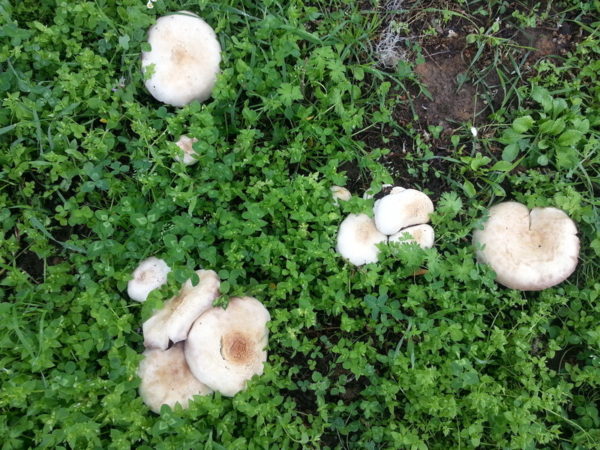
Basement breeding for beginners
Before you start growing mushrooms you need to properly prepare the room for the growth of mushrooms. It is better to approach this issue seriously, since the harvest and the quality of mushrooms depend on the growing conditions.
To prepare the basement for the cultivation of mushrooms, it is important to hold the following activities:
- Clear the basement of residues of vegetables;
- To whitewash the walls and ceiling with lime, with copper sulfate added to it;
- If as a result of storage of vegetables in the basement there is the presence of fruit midges, it is necessary to treat the premises with chlorophos;
- At the entrance to arrange the box with sawdust soaked in disinfectants. This will prevent bacteria from entering the room;
- Disinfect all surfaces and racks;
- Install additional ventilation, air conditioning and air purifiers;
- There should be no mold on the ceiling and walls;
- After processing the room is well ventilated.
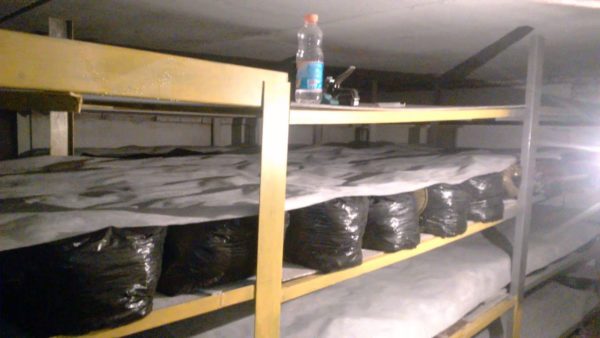
Preparing the substrate at home
To prepare the substrate will need;
- Horse manure - 100 kg;
- dry straw - 100 kg;
- urea — 2.5 kg;
- gypsum — 8 kg;
- superphosphate — 2 kg;
- chalk - 5 kg;
- water — 400 liters.
The preparation of nutrient compost needs to be practiced outdoors or in a well-ventilated area. If the substrate is prepared on the street, then it is advisable to build a shed to protect the compound from rain and direct sunlight. The straw is soaked and left for 2 days.
After soaking the straw and manure are mixed and left to re-digest. After 3 days, the composition is mixed, add urea and superphosphate. When adding these components, a caustic ammonia odor appears.
On the 7th day, gypsum or alabaster is added to the composition, the composition is well mixed so that the upper layer moves inwards. After another 3 days, make chalk and add water. Then two more interceptions are made every 4 days. When performing cuttings, all components must be thoroughly mixed so that they are evenly distributed in the total mass.
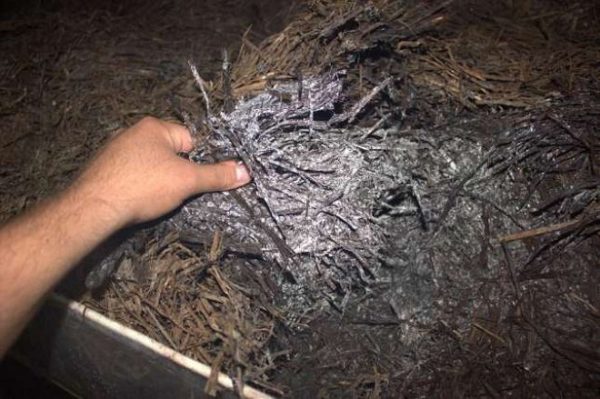
When the compost pereperet, it will become dark brown, the smell of ammonia will disappear. The mass will be springy, the straw will become soft, and the compost will leave a wet mark on the palms during compression.If during the compression water is released from the substrate, it must be smashed again and scattered to dry. You can add 2 kilograms of chalk. The composting process takes 21 days. This volume is enough for an area of 3 square meters. meter
Planting mushroom mycelium at home in the cellar
When the substrate is ready it is lowered into the basement, laid out in boxes or bags for growing mushrooms and planted with mycelium. You can buy it in special stores, or in farms engaged in the cultivation of mushrooms.
It is necessary to deepen the mycelium to a depth of 5 cm. The distance between the indentations should be at least 20 cm. It is recommended to perform the landing in a checkerboard pattern. After planting, the mycelium is sprinkled with soil.
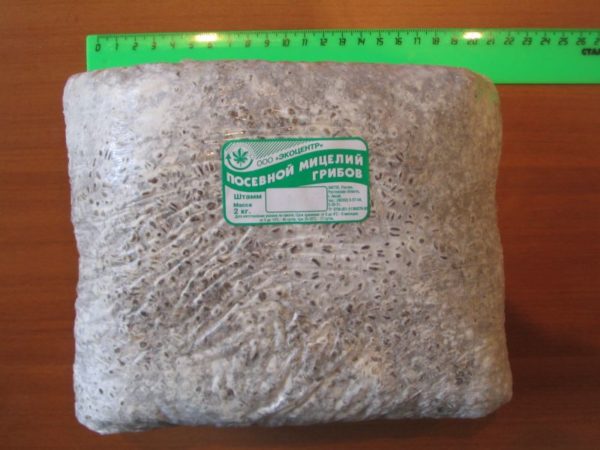
If spores of fungi are planted, in this case they are sown on the surface of the prepared soil. After sowing, spores are not sprinkled and the soil does not require additional moisture. It is important to cover the soil with a cloth and moisten it regularly. Within 5 days there will be a growth of mycelium. At this time, it is necessary to maintain indoor air humidity of 80–92% and temperature from 22 to 27 degrees.After 12 days, when the enhanced growth of fungal filaments begins, the surface should be filled with a mixture of the following ingredients:
- peat - 5 parts;
- soil - 4 parts;
- limestone - 1 part.
Layer must be at least 3 centimeters thick. After laying out the top layer should take another 5 days. The soil should be moistened periodically.
After 5 days the temperature in the room must be lowered to 13-16 degrees. During this period, the growth of fungi begins.
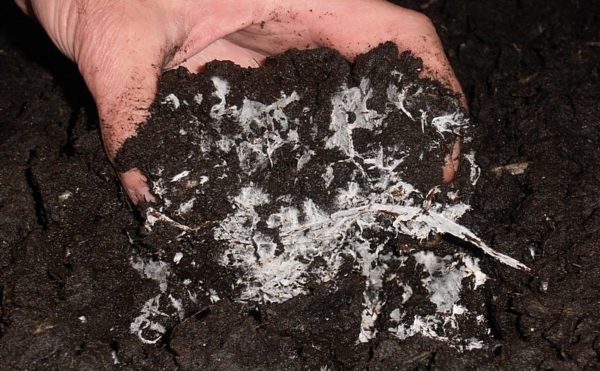
Distillation of fruit bodies
The first harvest can be taken after four months. It is important to ensure that the mushrooms are not overripe. The collection should be made at the moment when there is still a white film on the underside of the cap and no brown plates are visible. Mushrooms can not be cut with a knife, as from the remnants of the cut leg can get into the mycelium infection. Every mushroom must be carefully unscrewed.
After harvesting, the places where the mushrooms grew should be covered with soil.Within 7-14 days, active growth of fungi will occur, which will give an opportunity to harvest up to 8 times. The largest amount can be collected in the first three collections, then the yield drops.
Technology of growing mushrooms in open beds
You can grow champignons not only indoors, but also in open beds.
The ideal location would be the location under a canopy or next to a wall or brick fence. This will protect the mycelium from sunlight and rain.
The convenience of growing mushrooms in open ground is that no additional ventilation is required, the bed is ventilated naturally, which prevents the risk of rotting mycelium in the ground.
For growing in an open garden, chicken manure, horse manure or cow manure mixed with straw will be suitable.
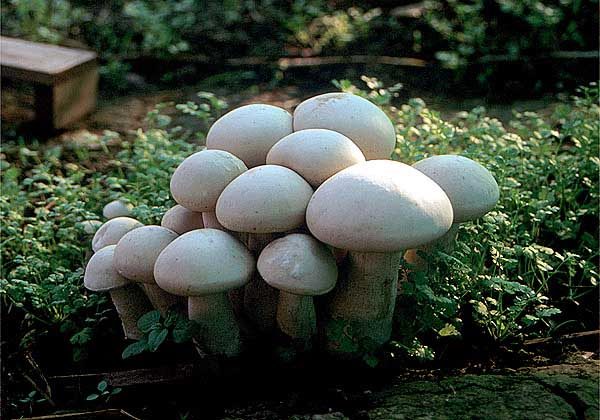
What is the mycelium in the country
For planting and cultivation of mushrooms is needed mycelium. The mycelium is the root system of the fungus, which is a network of white thin filaments located in the upper layer of the soil. Its task is to reproduce mushrooms. It grows out of the spores that are contained in the overripe mushroom cap in the process of dying. It needs moisture to grow successfully.
Landing in open beds
For planting the plot to cook better in the fall. In the selected area it is necessary to remove the top layer of soil 30 cm. The bed should be at least 1 meter wide. The distance between the rows is 55 cm. A layer of expanded clay must be poured at the bottom; it will serve as a drainage layer.
The layer thickness should be 9 cm. Then weed is thrown over the drainage layer, watered with a mullein solution, sprinkled with the soil removed from this bed and left until next year. Before laying the substrate on the beds, the soil must be disinfected. To do this, you can use a solution of the carbathion. The thickness of the substrate should be 22 cm. Spread it out with waves, whose height is 32 cm and the base is 52 cm.
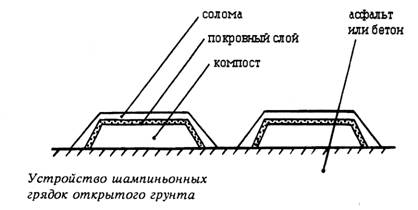
In the substrate it is necessary to make holes at least 5 cm deep. Mycelium must be deepened into the hole 2 cm below the surface of the soil and cover it with a substrate. If the mycelium is grain, then it is enough to scatter it on the surface of the soil, sprinkle with a layer of substrate in three cm. And gently rammed.
Provided that the temperature of the soil +25 degrees the growth of the mycelium will occur within two weeks. If the temperature is +30, the mycelium will die. For convenience, the mycelium is planted in a staggered manner with an interval of 25 cm honey wells. At the end of the planting beds must be mulched straw, it will prevent the evaporation of moisture. Layer thickness should be 25 cm.
Periodically moisten the straw gently so that water does not fall on the substrate. Check the process of sprouting mycelium possible after 5 days. To do this, gently raise the compost. In 14-21 days the surface of the substrate will be woven over the threads of mycelium.
After rooting the mycelium, the straw must be removed and the mycelium covered with a covering layer. Coating primer is prepared as follows:
- peat — 9 parts;
- chalk - 1 part.
The soil must be wet. Spread it over the surface, compacted and covered with straw again. The thickness of the soil should be 3.5 cm.
After 7-10 days, the first mushrooms should appear. If the weather is hot, the fruiting may cease. With the onset of a decrease in temperature by several degrees, the mushrooms resume growth.
Mushrooms are harvested 21-30 days after planting.. It is necessary to collect mushrooms when the hat begins to get a pink shade. It is impossible to leave ripe mushrooms, as they will weaken the mycelium. In addition, over-ripe champignons significantly deteriorate the taste. When collecting mushrooms do not cut. They must be carefully unscrewed. New mushrooms grow within two months.
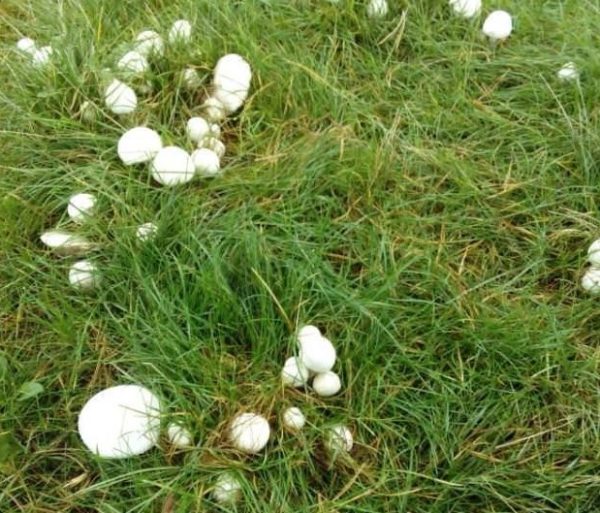
The profitability of growing mushrooms at home
In order to understand how profitable it is to grow champignons at home, it is necessary to clearly understand all the nuances of this business, namely:
- rental of finished premises or construction of a new one;
- buying mycelium;
- disinfection means for treating the premises;
- necessary equipment (racks, containers);
- equipment for ventilation and air purification;
- sanitary examination of finished products.
Let's try to calculate the cost part:
- compost 20 tons — 13,335 rubles;
- mycelium — 6,700 rubles;
- space heating — 33,335 rubles;
- salary — 40,000
Total — 93 370 rubles.
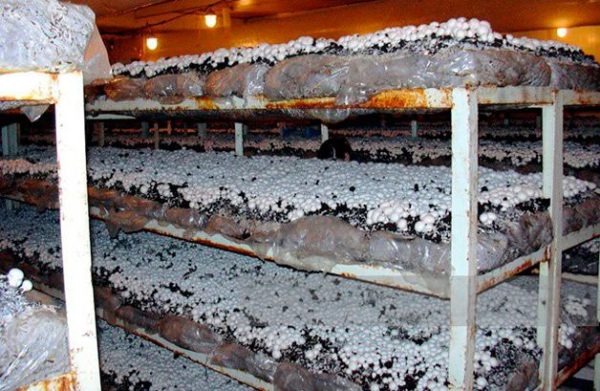
Calculation of profit:
On 20 tons of compost you can get 4 tons of finished products. The average cost of mushrooms is 150 rubles. With the implementation of 4 tons we get 600,000. Accordingly, the net profit will be 506 630 rubles.
However, these calculations do not take into account investments in equipment, premises and expenses arising in the process of cultivation. Accordingly, the cost recovery and the first profit can be expected no earlier than after 12 months if all the requirements regarding growing technology are met.
You can start growing champignons with several boxes, and having mastered the technology of cultivation,penetrating into all the nuances, you can safely develop this type of business.
